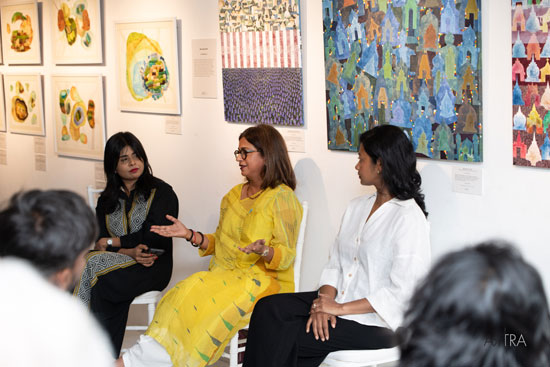By Devika Brendon
View(s):
On June 29, ARTRA Magazine hosted a very interesting discussion on the subject of Art Collecting. It took the form of an informal panel discussion, with the Editor of ARTRA, Azara Jaleel, interviewing Niloo Jayatilake and Thinushka de Soysa, both from the finance and corporate sphere and both art collectors, interested in the way the acquisition and holding of original artworks by Sri Lankan artists helps build culture and community, as well as increasing awareness and recognition of the tremendous creativity in this country.
The discussion was hosted in the home of a private collector, where guests could walk around and view the artworks as they hung on the walls, or were placed in specific viewing areas. There had been several ‘Artist Walks’ held here at different times during the week, during which contemporary artists led a group through a viewing of their work, discussing their influences, their themes, their choice of medium, and their artistic process and creative journey.

A discussion at a collector’s home: L-R, Azara Jaleel, Niloo Jayatilake and Thinushka de Soysa
The aim of the discussion was to offer insight into the world of art creation and acquisition: the fascinating process by which the work of a creative artist starts to become publicly known, recognised and valued, both monetarily and culturally.
The two speakers, in interaction with Azara, unfolded several aspects of this cultural landscape, one of them pointing out that it was only relatively recently that she had begun to consider herself a ‘collector’. She had grown up alongside several artists, as childhood friends, and had begun to purchase their work early in their careers. These works, bought decades ago, are now very valuable. But she highlighted that the joy she gains from seeing these works in her home, and resonating with her as part of her daily life, is the real measure of their value to her.
Artists become widely known through exhibiting their works. So the artistic community, and the interpersonal connections created and sustained within that community, are very significant. Friends and supporters become investors, and the owners of galleries and public spaces, as well as the curators of public art spaces which display artworks and showcase creatives, play an important role in the artist’s work becoming viewed as part of the culture in which it is created.
Organizations centred on promoting the work of specific artists, like the George Keyt Foundation, which celebrates the vibrant work of Sri Lanka’s most well known painter, and the Sapumal Foundation, which highlights the work of the ‘43 Group’, hold public viewings, and exhibitions, and fundraising events, throughout each year. The proceeds from these not only maintain the existing collections, but also help encourage and support young artists who are just starting out.
In the recent past, Udayshanth Fernando was one of the earliest promoters of young artists, by displaying and selling their artworks at Gallery Cafe for a few weeks at a time. Thereafter, his daughter Saskia set up an art gallery which does the same thing. Saskia has gone beyond her father with her annual KALA, where artists from here and South Asia come over to exhibit their works and talk about them. Both galleries are live and active, raising awareness and recognition of the works of art.
Azara pointed out in her discussion what an incredible growth has been taking place in recent years, among contemporary Sri Lankan artists, and that this shows positive progress and growth in the country’s cultural trajectory, as well as being a visible measure of its economic recovery and increased productivity.
The need is very clear to methodically facilitate the development of inter-generational interest and knowledge about the contemporary art world, and the past 100 years of work by Sri Lankan artists.
Viewing an artwork, the product of the creative vision of a fellow human being, is a repeating joy, and a source of inspiration and solace. Sometimes the subject matter of a painting or sculpture can be provocative, or prompt self reflection, and sometimes an artist can cause us to look anew at familiar sights, or think more deeply about political and social events which powerfully shape our lives, and the history of the country in which we live.
The companies in the corporate world who actively support the Sri Lankan creative sphere, such as the John Keells Group, and the Fairway Group, are displaying the works of contemporary painters not only in their board rooms but in public spaces. The Fairway Hotel, in Colombo, for example, showcases the work of Anoma Wijewardene on its walls.
The Galle Literary Festival, over the years, has also featured visual artists and the relatively new Ceylon Literary Festival, now in its second year, is also actively doing this, not only in one city, but in regional areas as well, aiming to make such events accessible to all.
The opportunity for artists to talk about their work, and participate in discussions about creativity in general, and their specific creative journeys, facilitated by groups and institutions dedicated to the creative arts, like AOD, the Academy of Design, and big hotels like the Cinnamon Group, which regularly offer their vibrant spaces to display the artworks, is also an opportunity for the public to gain insight and appreciation into the work process and artistic products of the remarkable creative talents who live and work amongst us.
Searching for an ideal partner? Find your soul mate on Hitad.lk, Sri Lanka’s favourite marriage proposals page. With Hitad.lk matrimonial advertisements you have access to thousands of ads from potential suitors who are looking for someone just like you.

